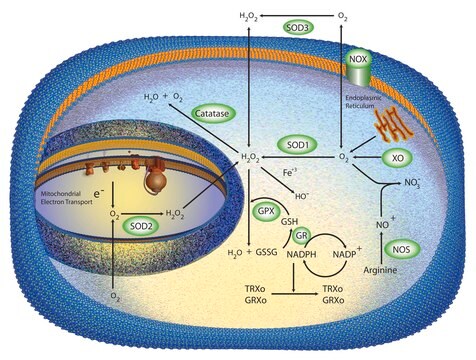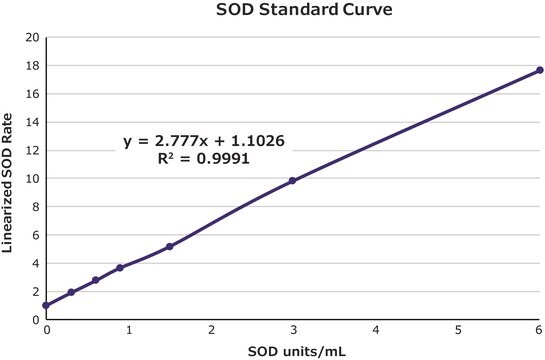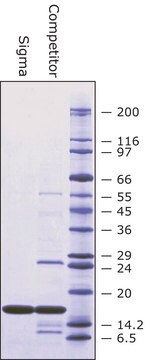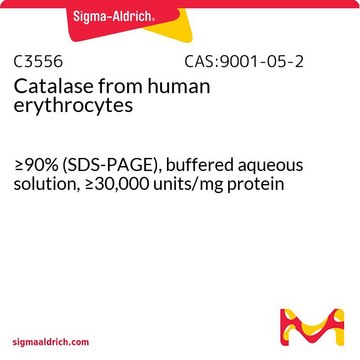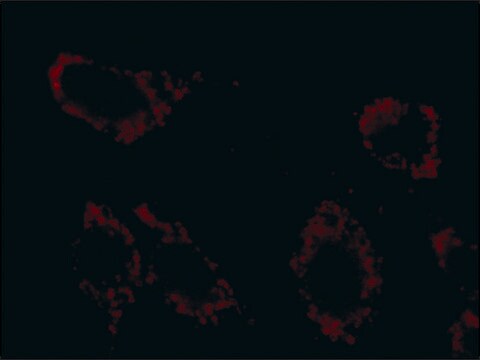S9636
Superoxide Dismutase from human erythrocytes
essentially salt-free, lyophilized powder, ≥2,500 units/mg protein
Synonyme(s) :
SOD, Superoxide: superoxide oxidoreductase
About This Item
Produits recommandés
Source biologique
human erythrocytes
Niveau de qualité
Essai
>80% protein (biuret)
Forme
essentially salt-free, lyophilized powder
Activité spécifique
≥2,500 units/mg protein
Poids mol.
32.0 kDa
Composition
Protein, ≥80% biuret
Fabricant/nom de marque
Sigma-Aldrich
Technique(s)
activity assay: suitable
Couleur
white to off-white
Plage de pH
7.6—10.5
pH
7.8
Adéquation
suitable for molecular biology
Application(s)
life science and biopharma
Température de stockage
−20°C
Informations sur le gène
human ... SOD1(6647) , SOD2(6648) , SOD3(6649)
Vous recherchez des produits similaires ? Visite Guide de comparaison des produits
Description générale
Application
- to test its effect on human neutrophils in reactive oxygen species (ROS) measurement studies involving Pseudomonas aeruginosa infection
- as an antioxidant to test its effect on ROS generation induced by atmospheric-pressure plasma jet (APPJ) in red blood cell (RBC) homogenates using optical spectroscopy studies
- to test its attenuating effect on hemoglobin (Hb)-induced nuclear factor-kappa B (NF- κB) and hypoxia-inducible factor (HIF) activity in human dermal microvascular endothelial cells (HMECs-1)
- as a reference antioxidant protein to examine its expression in human intestinal Caco-2 cells following treatment with dietary flavonoids
- in combination with catalase to promote cell differentiation in vitro
Actions biochimiques/physiologiques
Définition de l'unité
Remarque sur l'analyse
Mention d'avertissement
Danger
Mentions de danger
Conseils de prudence
Classification des risques
Resp. Sens. 1
Code de la classe de stockage
11 - Combustible Solids
Classe de danger pour l'eau (WGK)
WGK 1
Point d'éclair (°F)
Not applicable
Point d'éclair (°C)
Not applicable
Équipement de protection individuelle
Eyeshields, Gloves, type N95 (US)
Faites votre choix parmi les versions les plus récentes :
Déjà en possession de ce produit ?
Retrouvez la documentation relative aux produits que vous avez récemment achetés dans la Bibliothèque de documents.
Les clients ont également consulté
Articles
Oxidative stress is mediated, in part, by reactive oxygen species produced by multiple cellular processes and controlled by cellular antioxidant mechanisms such as enzymatic scavengers or antioxidant modulators. Free radicals, such as reactive oxygen species, cause cellular damage via cellular.
Protocoles
Enzymatic Assay of Superoxide Dismutase
Notre équipe de scientifiques dispose d'une expérience dans tous les secteurs de la recherche, notamment en sciences de la vie, science des matériaux, synthèse chimique, chromatographie, analyse et dans de nombreux autres domaines..
Contacter notre Service technique